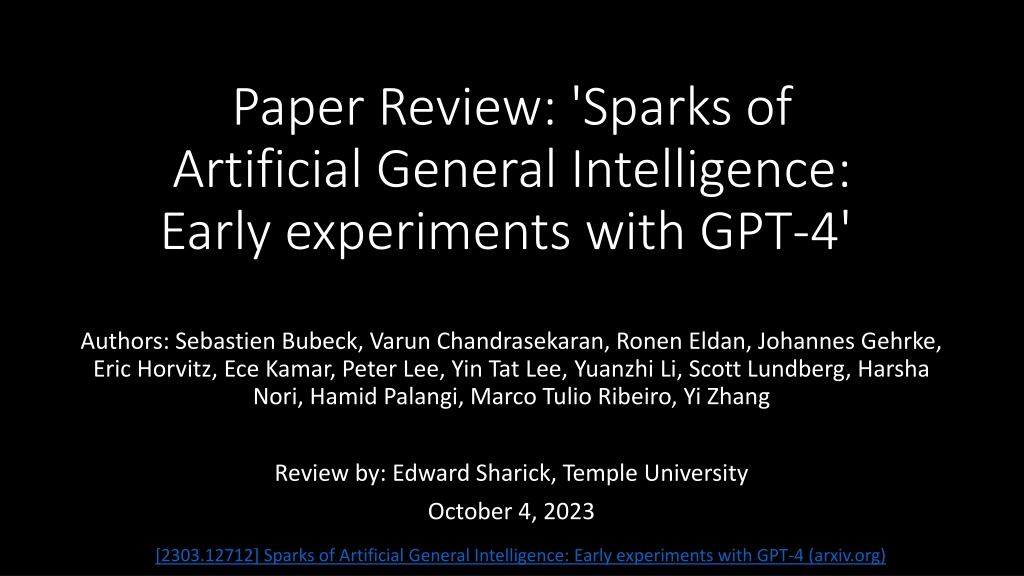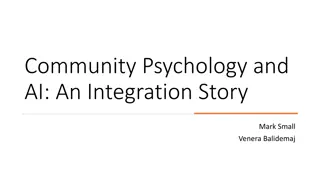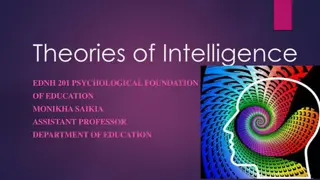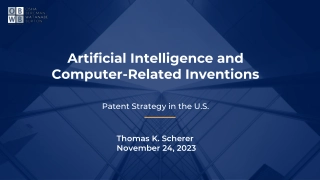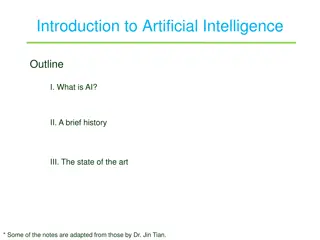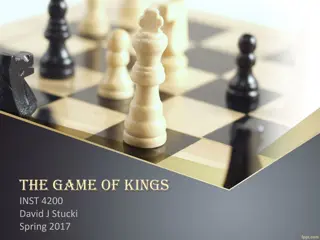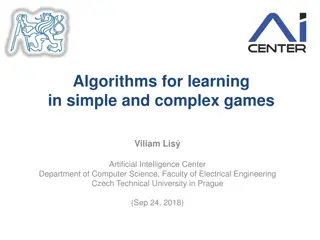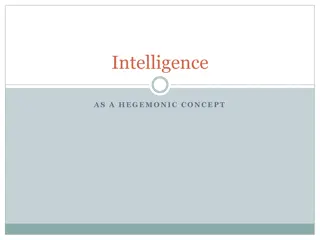Paper Review: 'Sparks of Artificial General Intelligence
This paper delves into the capabilities of GPT-4, comparing it with other models and aiming to showcase its intelligence as an early form of AGI. By proposing a novel evaluation approach based on creativity and curiosity, the authors attempt to demonstrate GPT-4's deep understanding and flexibility in various domains. The focus on integrative abilities, spanning vision, audio, art, programming, literature, math, history, and physics, highlights the breadth of intelligence being measured.
Download Presentation

Please find below an Image/Link to download the presentation.
The content on the website is provided AS IS for your information and personal use only. It may not be sold, licensed, or shared on other websites without obtaining consent from the author. Download presentation by click this link. If you encounter any issues during the download, it is possible that the publisher has removed the file from their server.
E N D
Presentation Transcript
Paper Review: 'Sparks of Artificial General Intelligence: Early experiments with GPT-4' Authors: Sebastien Bubeck, Varun Chandrasekaran, Ronen Eldan, Johannes Gehrke, Eric Horvitz, Ece Kamar, Peter Lee, Yin Tat Lee, Yuanzhi Li, Scott Lundberg, Harsha Nori, Hamid Palangi, Marco Tulio Ribeiro, Yi Zhang Review by: Edward Sharick, Temple University October 4, 2023 [2303.12712] Sparks of Artificial General Intelligence: Early experiments with GPT-4 (arxiv.org)
Outline of the paper review 1. Give a big picture view on what I believe is the authors' purpose 2. Review some of the GPT-4 experiments outlined in the paper 3. Review the author's conclusions 4. Discuss definition of "Intelligence" and AGI with relation to GPT-4
The main purpose of this paper 1. Explore the capabilities of GPT-4 2. Compare GPT-4 with Chat GPT and other LLMs 3. Find limitations of GPT-4 and LLMs in general 4. Prove that GPT-4 is intelligent and an early version of AGI
How did they evaluate GPT4? LLMs are traditionally evaluated based on benchmarks but they argue that there is limitations to these evaluations I agree with this They propose a different approach to studying GPT-4 which is closer to traditional psychology rather than machine learning, leveraging human creativity and curiosity. They aim to generate novel and difficult tasks and questions that convincingly demonstrate that GPT-4 goes far beyond memorization, and that it has a deep and flexible understanding of concepts, skills, and domains
Multimodal and interdisciplinary composition A key measure of intelligence is the ability to synthesize information from different domains or modalities and the capacity to apply knowledge and skills across different contexts or disciplines Integrative ability Vision Audio
Integrative ability Art and programming: produce javascript code which generates random images in the style of the painter Kandinsky. Literature and math: produce a proof of the fact there are infinitely many prime numbers in the literary style of Shakespeare. History and physics: write a supporting letter for Electron as a US presidential candidate, written by Mahatma Gandhi and addressed to his wife.
Vision When prompting the model to generate images of objects such as a cat, a truck or a letter in the alphabet using Scalable Vector Graphics (SVG), the model produces code which usually compiles to rather detailed and identifiable images
Vision One may hypothesize, however, that the model simply copied the code from training data, where similar images appear. Yet, the model appears to have a genuine ability for visual tasks, rather than just copying code from similar examples in the training data. Ex 1: prompted the model to draw a person by combining the shapes of the letters Y, O and H Ex 2: prompted to generate a picture of an object making use of a certain letter.
Vision Application: explore the possibility of combining GPT-4 and existing image synthesis models by using the GPT-4 output as the sketch.
Audio The model was trained also contains musical information encoded as ABC notation the model was able to produce valid tunes in ABC notation and, to some extent, explain and manipulate their structure the model was not able to produce any nontrivial form of harmony (possibly due to the fact that ABC notation is not commonly used)
Coding GPT-4 can handle a wide range of coding tasks GPT-4 can reason about code execution, simulate the effects of instructions, and explain the results in natural language GPT-4 has a high proficiency in writing focused programs that only depend on existing public libraries, which favorably compares to the average software engineer s ability GPT-4 is not perfect in coding yet sometimes produces syntactically invalid or semantically incorrect code sometimes fails to understand or follow the instructions sometimes produces code that does not match the intended functionality or style
Coding Challenges Benchmark GPT-4 on HumanEval Evaluated on LeetCode
Other Coding Examples Data Visualization Front-end/Game development Deep Learning Interfacing with LATEX
Understanding Existing Code Reverse-engineering assembly code Reasoning about code execution Executing Python Code Executing pseudo-code
Mathematical Abilities GPT-4 is still quite far from the level of experts and does not have the capacity required to conduct mathematical research GPT-4 can answer difficult (indeed, competitive) high-school level math questions, and can sometimes engage in meaningful conversation around advanced math topics GPT-4 can also make very basic mistakes and occasionally produce incoherent output which may be interpreted as a lack of true understanding Its mathematical knowledge and abilities can depend on the context in a seemingly arbitrary way
Mathematical Abilities To solve this question, one needs to first come up with the correct expression for the annual population change, use it to obtain a recurrence relation which leads to a system of equations, and finally solve the system of two equations. GPT-4 successfully arrives at the solution and produces a (mostly) sound argument. By comparison, across several independent attempts, ChatGPT consistently fails to implement any of the above steps, producing a nonsensical argument which results in an incorrect answer.
Mathematical Conversations When reasoning mathematically with GPT-4 and re-prompting when it makes errors, GPT-4 does not seem to follow its own reasoning. Often, the discussion leads to GPT-4 contradicting itself and producing increasingly incoherent arguments as the conversation continues.
Mathematical Conversations Begs the question: To what extent does the model demonstrate true understanding in mathematics? What is meant by true understanding? Three aspects: Creative reasoning selecting the right path to get to the solution, i.e. intuition GPT-4 does this well Technical proficiency Ability to perform routine calculations or manipulations GPT- 4 makes frequent mistakes, despite showing high degree of knowledge Critical reasoning Critically examine each step, break steps down into sub-steps, etc. GPT-4 does this part poorly
Interaction with the world Tool use using external resources (search engines, calculators, or other APIs) Embodied interaction using natural language as a text interface to interact with simulated or real-world environments and receive feedback from them.
Tool Use Give GPT access to the internet, calculator and other code functions It can send emails, search the web, manage a calendar, make reservations, etc.
Tool Use The examples in this section show that GPT-4 is capable of both identifying and using external tools on its own in order to improve its performance. It is able to reason about which tools it needs, effectively parse the output of these tools and respond appropriately (i.e., interact with them appropriately), all without any specialized training or fine- tuning. GPT-4 still requires a prompt that specifies it is allowed or expected to use external tools. GPT-4 is not always able to reason about when it should use external tools and when it should simply respond based on its own parametric knowledge (i.e. search for capital of paris, even though it knows)
Embodied Interaction Navigating a text-based game
Embodied Interaction Navigating a text-based game Real world "handyman"
Understanding Humans: Theory of mind Theory of mind - the ability to attribute mental states such as beliefs, emotions, desires, intentions, and knowledge to oneself and others, and to understand how they affect behavior and communication
Understanding Humans: Theory of mind Theory of mind - the ability to attribute mental states such as beliefs, emotions, desires, intentions, and knowledge to oneself and others, and to understand how they affect behavior and communication Findings suggest that GPT-4 has a very advanced level of theory of mind GPT-4 has more nuance and is able to reason better about multiple actors, and how various actions might impact their mental states, especially on more realistic scenarios
Discriminative Capabilities Discrimination - a component of intelligence that allows an agent to make distinctions between different stimuli, concepts, and situations PII Detection Misconceptions and Fact Checking
Shortcomings/Limitations The paper goes through many examples and does show some limitations of GPT-4 which are common to LLMs including: the problem of hallucinations or making basic arithmetic mistakes "This highlights the fact that, while GPT-4 is at or beyond human-level for many tasks, overall its patterns of intelligence are decidedly not human-like."
Limitations of autoregressive architecture highlighted by GPT-4 Flaws seem to be inherent to the "next-word" prediction Ex: Primes between 150 and 250
Limitations of autoregressive architecture highlighted by GPT-4 Lack of planning in arithmetic/reasoning problems However, if GPT-4 takes its time to answer the question then the accuracy easily goes up: Prompt: What is the value of the following expression? 116 * 114 + 178 * 157 = ? Let s think step by step to solve the expression, write down all the intermediate the steps, and only then produce the final solution.
Limitations of autoregressive architecture highlighted by GPT-4 the autoregressive nature of the model which forces it to solve problems in a sequential fashion sometimes poses a more profound difficulty that cannot be remedied simply by instructing the model to find a step-by-step solution
Limitations of autoregressive architecture highlighted by GPT-4 Lack of planning in text generation Local constraints seem fine Global constraints lead to problems
Types of Intellectual Task This points to the distinction between two types of intellectual tasks: Incremental tasks - can be solved in a gradual or continuous way, by adding one word or sentence at a time that constitutes progress in the direction of the solution Discontinuous tasks - tasks where the content generation cannot be done in a gradual or continuous way, but instead requires a certain Eureka idea that accounts for a discontinuous leap in the progress towards the solution of the task. Could also be interpreted as fast vs. slow thinking
The authors' claims/conclusions 1. GPT4 is part of a new cohort of LLMs that exhibit more general intelligence than previous AI models 2. Beyond its mastery of language, GPT-4 can solve novel and difficult tasks that span mathematics, coding, vision, medicine, law, psychology and more, without needing any special prompting 3. It can reasonably be viewed as an early (yet still incomplete) version of an artificial general intelligence (AGI) system
Expanding on Claim 3 "Our claim that GPT-4 represents progress towards AGI does not mean that it is perfect at what it does, or that it comes close to being able to do anything that a human can do (which is one of the usual definition of AGI), or that it has inner motivation and goals (another key aspect in some definitions of AGI). In fact, it is not fully clear how far GPT-4 can go along some of those axes of intelligence that we focus on, e.g., planning, and arguably it is entirely missing the learning from experience as the model is not continuously updating (although it can learn within a session)."
How do they define 'Intelligence'? "There is no generally agreed upon definition of intelligence, but one aspect that is broadly accepted is that intelligence is not limited to a specific domain or task, but rather encompasses a broad range of cognitive skills and abilities." (They don't really define it...) "AGI refers to systems that demonstrate broad capabilities of intelligence, including reasoning, planning, and the ability to learn from experience, and with these capabilities at or above human-level." "GPT4 exhibits many traits of intelligence demonstrates remarkable capabilities on a variety of domains and tasks, including abstraction, comprehension, vision, coding, mathematics, medicine, law, understanding of human motives and emotions, and more."
Intelligence - Some definitions Legg and Hutter - Intelligence measures an agent s ability to achieve goals in a wide range of environments Legg and Hutter An intelligent system is a system that can do anything a human can do Chollet Intelligence centers around skill-acquisition efficiency, i.e. learning from experience
Intelligence - Some definitions The essence of intelligence is the principle of adapting to the environment while working with insufficient knowledge and resources. Accordingly, an intelligent system should rely on finite processing capacity, work in real time, open to unexpected tasks, and learn from experience. This working definition interprets intelligence as a form of relative rationality (Wang, 2008) This was not in the paper :)
Expanding on Claim 3 "Our claim that GPT-4 represents progress towards AGI does not mean that it is perfect at what it does, or that it comes close to being able to do anything that a human can do (which is one of the usual definition of AGI), or that it has inner motivation and goals (another key aspect in some definitions of AGI). In fact, it is not fully clear how far GPT-4 can go along some of those axes of intelligence that we focus on, e.g., planning, and arguably it is entirely missing the learning from experience as the model is not continuously updating (although it can learn within a session)."
Argument for GPT-4's Ability to "Reason" "GPT-4 s primary strength is its unparalleled mastery of natural language. It can not only generate fluent and coherent text, but also understand and manipulate it in various ways, such as summarizing, translating, or answering an extremely broad set of questions. Moreover, by translating we mean not only between different natural languages but also translations in tone and style, as well as across domains such as medicine, law, accounting, computer programming, music, and more, see the Plato dialogue in Figure 1.6. These skills clearly demonstrate that GPT-4 can manipulate complex concepts, which is a core aspect of reasoning." Is mapping alone enough to be called reasoning?
Argument for GPT-4's Ability to "Reason" Coding and mathematics are emblematic of the ability to reason. Chat GPT is proficient and solving some mathematics problems and coding problems (as will be shown). Preliminary tests on the multiple-choice component of the US Medical Licensing Exam Step 1, 2, and 3 had an accuracy around 80% in each. Preliminary test of GPT-4 s competency on the Multistate Bar Exam showed an accuracy above 70%.
Proficiency = Intelligence? "A question that might be lingering on many readers mind is whether GPT-4 truly understands all these concepts, or whether it just became much better than previous models at improvising on the fly, without any real or deep understanding. We hope that after reading this paper the question should almost flip, and that one might be left wondering how much more there is to true understanding than on- the-fly improvisation. Can one reasonably say that a system that passes exams for software engineering candidates (Figure 1.5) is not really intelligent? Perhaps the only real test of understanding is whether one can produce new knowledge, such as proving new mathematical theorems, a feat that currently remains out of reach for LLMs."
Concluding points from the authors 1. Initial exploration of GPT-4's capabilities suggest that it performs at a human-level on many tasks and domains 2. Assessing GPT-4's intelligence without a formal definition is challenging. Need in the ML community for the development of more comprehensive evaluation methods. 3. GPT-4 exhibits elements of artificial general intelligence (AGI) through its core mental capabilities, range of expertise, and task versatility, but there is more work needed to achieve complete AGI.
On the path to more general AI Confidence calibration Long-term memory Continual learning Personalization Planning and conceptual leaps Transparency, interpretability and consistency Cognitive fallacies and irrationality Challenges with sensitivity to inputs
Can LLM's get past these problem? Which of the drawbacks can be mitigated within the scope of next word prediction? Is it simply the case that a bigger model and more data will fix those issues, or does the architecture need to be modified, extended, or reformulated? Potential extensions: External calls by the model to components and tools A richer, more complex slow-thinking deeper mechanism that oversees the fast-thinking mechanism of next word prediction. Integration of long-term memory as an inherent part of the architecture Going beyond single-word prediction
The authors' claims My Response/Thoughts 1. GPT4 is part of a new cohort of LLMs that exhibit more general intelligence than previous AI models Agree in that they are more capable of doing more tasks, more effectively. I don't necessarily agree that this is exhibiting "intelligence". 2. Beyond its mastery of language, GPT-4 can solve novel and difficult tasks that span mathematics, coding, vision, medicine, law, psychology and more, without needing any special prompting Again, this is true, but I feel that the way it is solving these problems is not an example of "intelligence". 3. It can reasonably be viewed as an early (yet still incomplete) version of an artificial general intelligence (AGI) system I believe the inherent limitations of LLM's architecture and algorithm prevent it from ever achieving true AGI.
